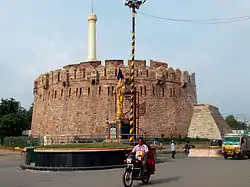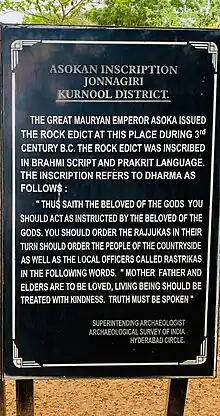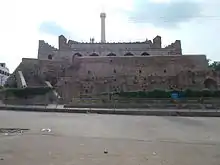Kurnool
Kurnool is a city in the state of Andhra Pradesh, India. It formerly served as the capital of Andhra State (1953–1956). And is probably going to serve as the judicial capital of Andhra Pradesh in 2024.[5][6][7] The city is often referred to as "The Gateway of Rayalaseema". Kurnool is also known as The City of Gem Stones. It also serves as the district headquarters of its Kurnool district. As of 2011 census, it is the fifth most populous city in the state with a population of 484,327.[3][8] It is located on the banks of the Tungabhadra river. Although the area has been inhabited for thousands of years, modern Kurnool was founded in the 16th century CE with the construction of the Konda Reddy Fort.
Kurnool
Kandanavōlu (Kandanōlu) | |
|---|---|
City | |
 Top: Konda Reddy Fort Bottom: View of Kurnool city from Abhayanjaneya Swamy Temple | |
| Nickname: The Gateway of Rayalaseema | |
.svg.png.webp) Kurnool Location in Andhra Pradesh and in India  Kurnool Kurnool (India) | |
| Coordinates: 15.83°N 78.05°E | |
| Country | |
| State | Andhra Pradesh |
| Region | Rayalaseema |
| District | Kurnool |
| Area | |
| • City | 69.51 km2 (26.84 sq mi) |
| • Rank | 107 |
| Elevation | 274 m (899 ft) |
| Population (2011)[2] | |
| • City | 425,214 |
| • Rank | 109th (India) 5th (Andhra Pradesh) |
| • Density | 6,100/km2 (16,000/sq mi) |
| • Metro | 484,327 |
| Demonym | Kurnoolion |
| Languages | |
| • Official | Telugu |
| Time zone | UTC+5:30 (IST) |
| PIN | 518001, 518002, 518003, 518004, 518005, 518006, 518007 |
| Vehicle registration | AP-21[4] |
| Website | Kurnool Municipal Corporation |
Etymology
The original name of Kurnool is found in historical records as Kandanavōlu or Kandanōlu.[9] It used to be a crossing on the Tungabhadra River, where the bullock cart caravans are believed to have greased their wheels ("kandana" being a reference to grease).[10] The city is often referred to as "The Gateway of Rayalaseema".[11]
History
Palaeolithic era
The Ketavaram[12] rock paintings from the Paleolithic era and are (18 kilometres from Kurnool). Also the Jurreru Valley, Katavani Kunta[13] and Yaganti in Kurnool District have some important rock art and paintings in the vicinity, may be dated from 35,000 to 40,000 years ago.
Ashoka's rock edicts were inscribed in 3rd-century BCE. The inscription is in Prakrit language and Brahmi script. Both the major and minor edits are found at Erragudi (also called Yerragudi or Jonnagiri site). These are among the oldest discovered inscriptions in India. The site is close to Andhra-Karnataka border, in Kurnool district. It is an ASI protected site under Indian laws.

Belum Caves are geologically and historically important caves in the district. There are indications that Jain and Buddhist monks were occupying these caves centuries ago. Many Buddhists relics were found inside the caves. These relics are now housed in Museum at Ananthapur. Archaeological survey of India (ASI) found remnants of vessels and other artifacts of pre-Buddhist era and has dated the remnants of vessels found in the caves to 4500 BC.[14]
Vijayanagara era
Little was known about Kurnool town before the 11th century. The earliest knowledge of this settlement dates from the 11th century. It has developed as transit place on the southern banks of the river Tungabhadra.
Ruled by the Cholas in 12th Century and later taken over by the Kakatiya dynasty in 13th century. Kurnool developed into a transit point on the southern banks of the Tungabhadra River. It eventually fell under the rule of a jaghirdar before becoming a part of the Vijayanagar dynasty. King Achyuta Raya, successor of Sri Krishnadeva Raya constructed the Kurnool Fort during the 16th century.
Mughals Rule
The Abyssinian, Abdul Wahab Khan, defeated King Gopal Raja of the Vijayanagar Kingdom in the 17th century and went on to rule the land for 16 years until his death.
In 1686, Kurnool fell under the influence of the Mughals who were ruled by Emperor Aurangzeb. Later on in Kurnool's history, it was ruled by the Nawabs until the British Government took over in 1839.[15]
Nawabs
Ghulam Rasul Khan Bahadur (died on 12 July 1840) was the last Nawab of Kurnool, Andhra Pradesh.[16] He ruled from 1823 to 1839 until the kingdom was defeated by the East India Company.[17] On 12 October 1839, a war broke out between British Indian Army and the kingdom and continued for six days until the king was detained on 18 October. He was subsequently sent to Tiruchirappalli Central Prison where he died on 12 July 1840.[18]
Post independence
Kurnool was the capital of erstwhile Andhra State between 1 October 1953 and 31 October 1956.[19][20] The state was later merged with Telugu speaking districts of Hyderabad State to form Andhra Pradesh with Hyderabad as the state's capital on 1 November 1956.[21][22] Presently Kurnool is in the divided Andhra Pradesh state.
Geography
Kurnool is located at 15.8333°N 78.05°E.[23] It has an average elevation of 273 metres (898 feet). Kurnool lies on the banks of the Tungabhadra River. The Hundri and Neeva rivers also flow through the city. The K.C.Canal (Kurnool–Cuddapah) was built by the Dutch for transportation, but later used for irrigation.
Cityscape

Landmarks in and around the city include Konda Reddy Fort Formerly called Kondareddy Burj is the Historical Monuement and Major Tourist Attraction of Kurnool located at the north east part of the city.[24] Orvakal rock Garderns is the Sculpture Garden with Ancient cave lies on the South East of the city.[25]
Climate
Kurnool has a hot savanna climate (Köppen BSh) with temperatures ranging from 26 °C (78.8 °F) to 46 °C (114.8 °F) in the summer and 12 °C (53.6 °F) to 31 °C (87.8 °F) in the winter. The average annual rainfall is about 920 millimetres (36 in).
| Climate data for Kurnool (1981–2010, extremes 1901–2012) | |||||||||||||
|---|---|---|---|---|---|---|---|---|---|---|---|---|---|
| Month | Jan | Feb | Mar | Apr | May | Jun | Jul | Aug | Sep | Oct | Nov | Dec | Year |
| Record high °C (°F) | 37.3 (99.1) |
39.9 (103.8) |
43.3 (109.9) |
44.8 (112.6) |
45.6 (114.1) |
45.6 (114.1) |
38.5 (101.3) |
37.8 (100.0) |
38.7 (101.7) |
38.4 (101.1) |
38.8 (101.8) |
35.4 (95.7) |
45.6 (114.1) |
| Average high °C (°F) | 31.7 (89.1) |
34.8 (94.6) |
38.2 (100.8) |
40.1 (104.2) |
40.5 (104.9) |
36.2 (97.2) |
33.6 (92.5) |
32.5 (90.5) |
32.9 (91.2) |
32.5 (90.5) |
31.2 (88.2) |
30.5 (86.9) |
34.6 (94.3) |
| Average low °C (°F) | 17.9 (64.2) |
20.3 (68.5) |
23.8 (74.8) |
26.7 (80.1) |
27.5 (81.5) |
25.5 (77.9) |
24.5 (76.1) |
23.9 (75.0) |
23.8 (74.8) |
22.8 (73.0) |
20.1 (68.2) |
17.8 (64.0) |
22.9 (73.2) |
| Record low °C (°F) | 8.3 (46.9) |
11.1 (52.0) |
12.8 (55.0) |
15.5 (59.9) |
19.4 (66.9) |
17.6 (63.7) |
19.2 (66.6) |
19.9 (67.8) |
17.0 (62.6) |
13.0 (55.4) |
9.3 (48.7) |
6.7 (44.1) |
6.7 (44.1) |
| Average rainfall mm (inches) | 4.0 (0.16) |
2.2 (0.09) |
9.8 (0.39) |
26.4 (1.04) |
50.4 (1.98) |
93.6 (3.69) |
121.4 (4.78) |
143.4 (5.65) |
145.0 (5.71) |
114.1 (4.49) |
23.0 (0.91) |
3.9 (0.15) |
737.2 (29.02) |
| Average rainy days | 0.3 | 0.2 | 0.7 | 1.6 | 2.7 | 5.7 | 7.6 | 9.0 | 7.7 | 5.2 | 1.9 | 0.3 | 43.0 |
| Average relative humidity (%) (at 17:30 IST) | 35 | 26 | 23 | 25 | 28 | 45 | 54 | 57 | 57 | 56 | 51 | 44 | 42 |
| Source: India Meteorological Department[26][27] | |||||||||||||
Demographics
As per final data of 2011 census, Kurnool urban agglomeration had a population of 484,327, making it the fifth largest city in the state of Andhra Pradesh.[28] The literacy rate of Kurnool was 77.37 per cent at the time of the 2011 census.
Religion
As per final data of 2011 census, Hindus formed the majority in the Kurnool urban agglomeration. Other religious groups found in Kurnool are Muslims, Christians, and Jains.[29]
Government and politics
Kurnool serves as the district headquarters of its Kurnool district.[31][32] The city is administered by Kurnool Municipal Corporation.
Education
The primary and secondary school education is imparted by Government, aided and private schools of the School Education Department of the state.[33][34] Notable institutions located in the city include:
- Kurnool Medical College
- Osmania College
- Rayalaseema University
- Indian Institute of Information Technology Design and Manufacturing Kurnool
- Silver Jubilee Government College
Transport
Roadways
National Highway 44 (India) which runs from Srinagar to Kanyakumari and also highway of Bangalore to Hyderabad. passes through Kurnool.
National highway 340C [ Kurnool-Dornala ] which connects to Srisailam, Vinukonda, Guntur, Vijayawada.
National Highway 40, [ Rayalaseema Expressway ] which runs from Kurnool to Chittoor, are the major highways passing through the city.
The city has a total road length of 519.22 km[35] State owned bus transport system, APSRTC, operates buses from Kurnool bus station to other parts of the state.[36][37]
Railways
Kurnool City railway station lies on the Bengaluru – Hyderabad railway line. It is classified as an A–category station in the Hyderabad railway division of South Central Railway zone. Another railway station name Kotla lies in the middle of the city.
Airport
Kurnool Airport, officially known as Uyyalawada Narasimha Reddy Airport, is located at Orvakal and is situated on the National Highway 40, about 18 km (11 mi) from Kurnool and 54 km (34 mi) from Nandyal. Commercial operations of the greenfield airport were started in March 2021.
Economy
Kurnool is endowed with good mineral resources. The important minerals are Iron ore, dolomite, limestone, ochre, quartz and silica.[38]
Notable people
- Abdul Hafeez Khan, MLA Kurnool, YSRCP
- K. E. Krishnamurthy, former Deputy Chief Minister, Andhra Pradesh
- Arcot Ramasamy Mudaliar - Founder of Justice party, Diwan of Mysore and the First President of UNESCO
- Kotla Jayasurya Prakasha Reddy, former member of parliament and Union minister, Railways
- Kotla Vijaya Bhaskara Reddy, former Chief Minister, United Andhra Pradesh
- Damodaram Sanjivayya, former Chief Minister, United Andhra Pradesh
- Machani Somappa, industrialist and recipient of Padma sri honour
- T. G. Venkatesh, Indian businessman and politician
See also
References
- "Kurnool Municipal Corporation |". kurnool.cdma.ap.gov.in. Archived from the original on 3 December 2019. Retrieved 29 October 2017.
- "Cities having population 1 lakh and above, Census 2011" (PDF). Office of the Registrar General & Census Commissioner, India. Retrieved 29 May 2021.
- "Urban Agglomerations/Cities having population 1 lakh and above" (PDF). Office of the Registrar General & Census Commissioner, India. Retrieved 29 May 2021.
- "Registration | District Codes | Transport Department Government of Andhra Pradesh – India". aptransport.org.
- Gopi Dara (22 November 2021). "AP Capital News: Andhra Pradesh govt withdraws three-capitals bills | Vijayawada News - Times of India". The Times of India. Retrieved 22 November 2021.
- "Andhra Pradesh high court orders status quo on two new laws for three capitals". TOI. 4 August 2020.
- "Andhra Governor gives nod to CM Jagan Mohan Reddy's three-capital plan". Livemint. 1 August 2020. Retrieved 2 August 2020.
- "Andhra Pradesh (India): Districts, Cities and Towns - Population Statistics, Charts and Map". www.citypopulation.de. Retrieved 17 April 2020.
- Iswara Dutt, K. (1937), "Kamma commanders of the Vijayangara armies", Journal of the Andhra Historical Society, Andhra Historical Research Society, pp. 222–224
- "Heritage in Kurnool". AP Tourism Department. Archived from the original on 13 July 2014. Retrieved 10 August 2014.
- Sarkar, Siddhartha (2011). International Journal of Economic and Political Integration: Vol.1, No.1. Universal-Publishers. p. 15. ISBN 978-1-61233-544-5. Retrieved 18 July 2015.
- "Archived copy" (PDF). Archived from the original (PDF) on 17 December 2013. Retrieved 15 June 2014.
{{cite web}}: CS1 maint: archived copy as title (link) - Petraglia, Michael. "New rock art discoveries in the Kurnool District, Andhra Pradesh, India". Antiquity. academia.edu. 84 (324): 335–350. Retrieved 28 May 2014.
- Show Caves of India: Belum Caves
- Cahoon, Ben. "Indian Princely States K-Z".
- "Wahab Khan tomb in Kurnool to get a facelift". The Hindu. 2 July 2013 – via www.thehindu.com.
- "Bonhams : A silver seal made for Ghulam Rasul Khan Bahadur, Nawab of Kurnool (reg. 1823-39) South Deccan, dated AH 1239/AD 1823-24". www.bonhams.com.
- Ahamed, Syed Naseer (28 November 2017). "Nawab of Kurnool Ghulam Rasool Khan A Great Freedom Fighter of India who fought against the British Empire".
- "Andhra Pradesh - History". Encyclopedia Britannica. Retrieved 17 April 2020.
- "First Capital of AP". Archived from the original on 15 June 2020. Retrieved 17 April 2020.
- "The Indian Express – Google News Archive Search". google.com.
- Somasekhar, Ch RS Sarma / M. "Capital loss: Madras, Kurnool, now Hyderabad". The Hindu Business Line. Retrieved 11 April 2016.
- "Maps, Weather, and Airports for Kurnool, India". fallingrain.com.
- "Gopal Darwaza stands as a witness to history". The Hindu. Kurnool. 22 April 2014. Retrieved 28 February 2016.
- Kurmanath, K.V (22 June 2006). "A rocky, solid gift from nature". The Hindu Business Line. Orvakal (Kurnool district). Retrieved 28 February 2016.
- "Station: Kurnool Climatological Table 1981–2010" (PDF). Climatological Normals 1981–2010. India Meteorological Department. January 2015. pp. 443–444. Archived from the original (PDF) on 5 February 2020. Retrieved 18 February 2020.
- "Extremes of Temperature & Rainfall for Indian Stations (Up to 2012)" (PDF). India Meteorological Department. December 2016. p. M12. Archived from the original (PDF) on 5 February 2020. Retrieved 18 February 2020.
- "Kurnool City Population Census 2011-2019 | Andhra Pradesh". www.census2011.co.in.
- "Table C-01 Population by Religion: Andhra Pradesh". Census of India. Registrar General and Census Commissioner of India. 2011.
- "Table C-16 Population by Mother Tongue: Andhra Pradesh (Town level)". Census of India. Registrar General and Census Commissioner of India.
- "District Census Handbook : Kurnool" (PDF). Census of India. p. 50. Retrieved 21 August 2015.
- Staff Reporter (20 January 2020). "Andhra Pradesh Cabinet clears decentralised capital across Amaravati, Visakhapatnam and Kurnool". The Hindu. ISSN 0971-751X. Retrieved 17 April 2020.
- "School Education Department" (PDF). School Education Department, Government of Andhra Pradesh. Archived from the original (PDF) on 19 March 2016. Retrieved 7 November 2016.
- "The Department of School Education – Official AP State Government Portal | AP State Portal". www.ap.gov.in. Archived from the original on 7 November 2016. Retrieved 7 November 2016.
- "Details of Roads in Each ULB of Andhra Pradesh". Archived from the original on 1 August 2016.
- "Bus Stations in Districts". Andhra Pradesh State Road Transport Corporation. Archived from the original on 22 March 2016. Retrieved 8 March 2016.
- Krishnamoorthy, Suresh (22 April 2015). "Several bus stations lack CCTV surveillance". The Hindu. Hyderabad. Retrieved 8 March 2016.
- "Archived copy" (PDF). Archived from the original (PDF) on 19 February 2018. Retrieved 30 October 2015.
{{cite web}}: CS1 maint: archived copy as title (link)
External links
 Kurnool travel guide from Wikivoyage
Kurnool travel guide from Wikivoyage- Kurnool district Mandal Information
